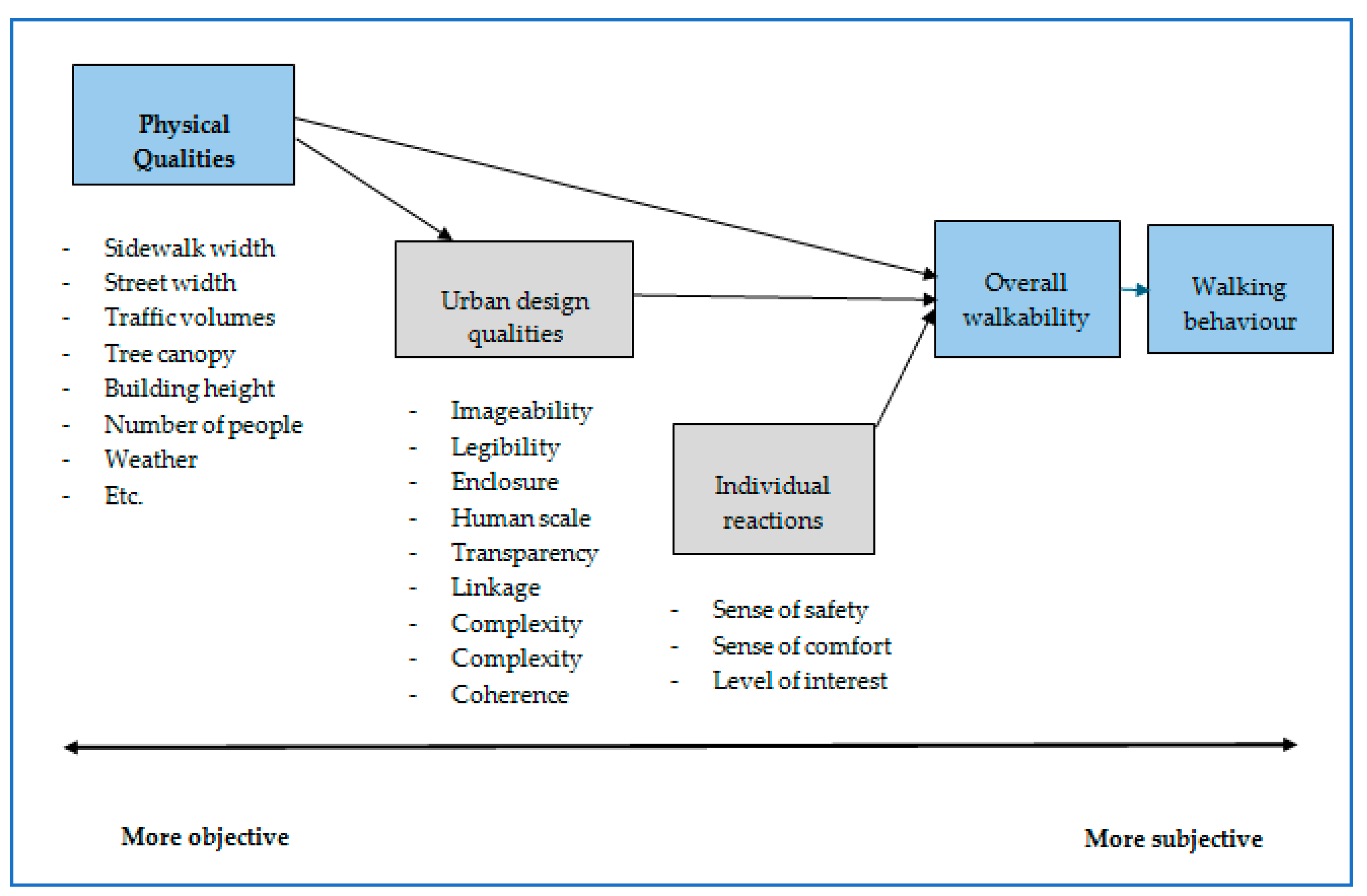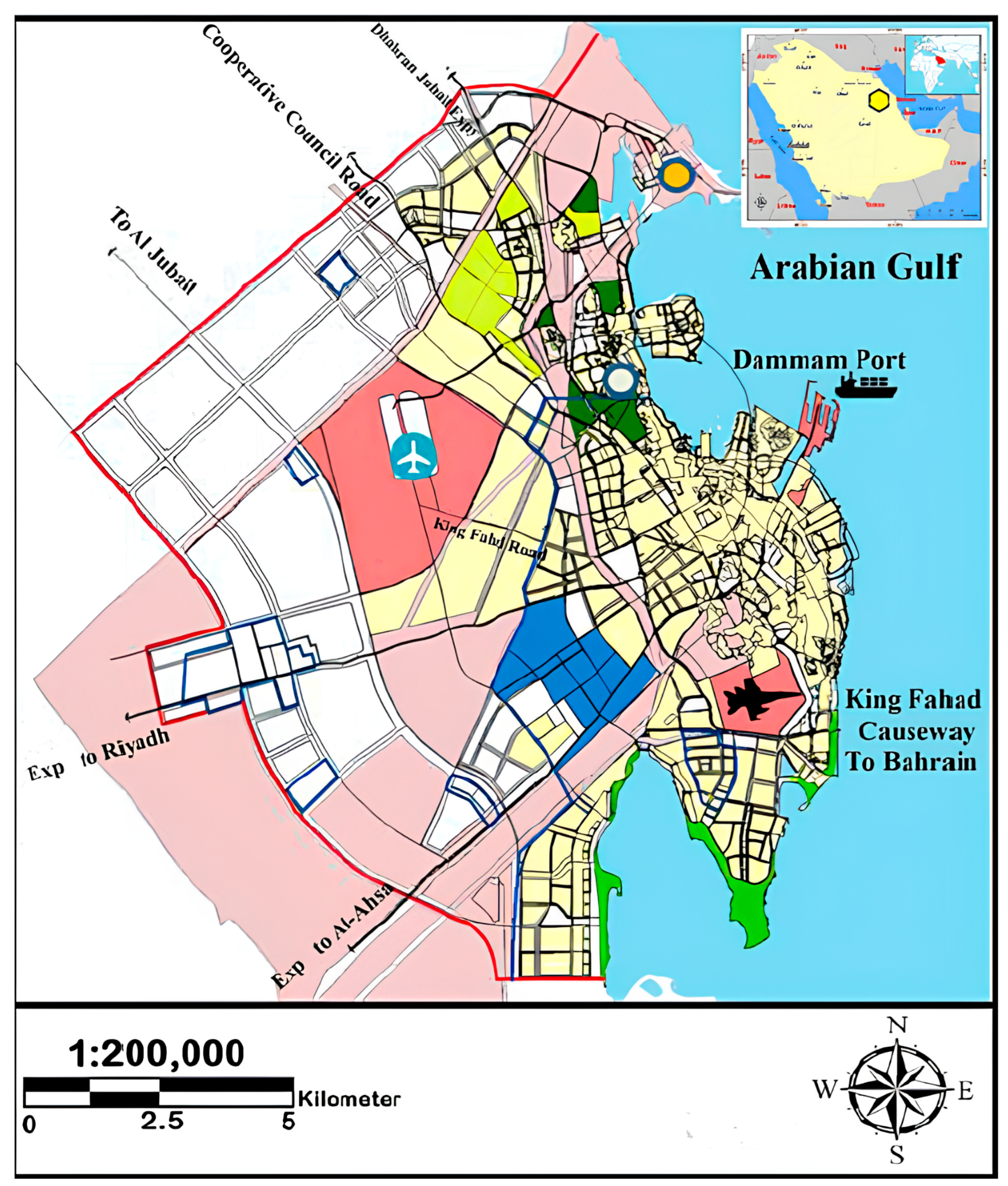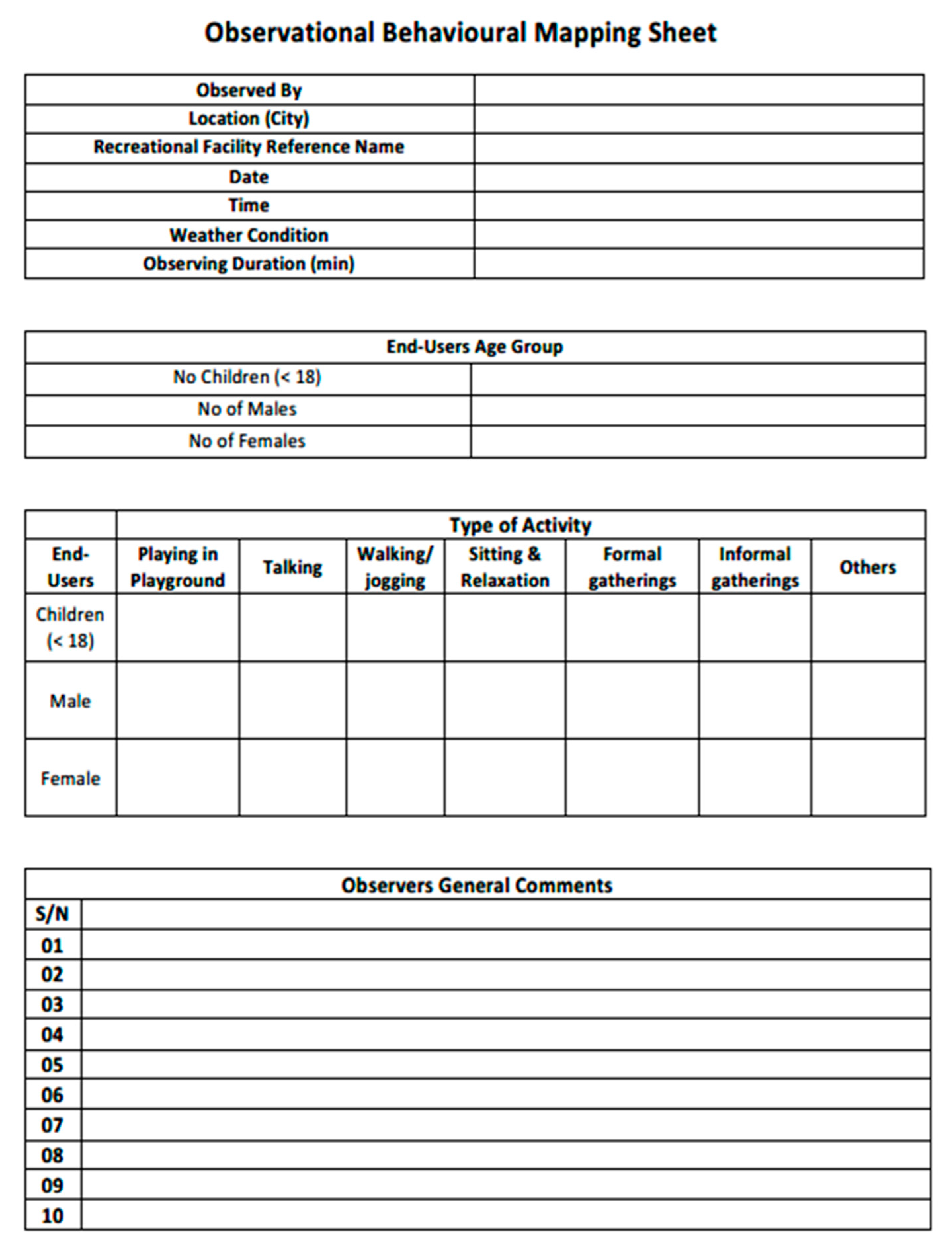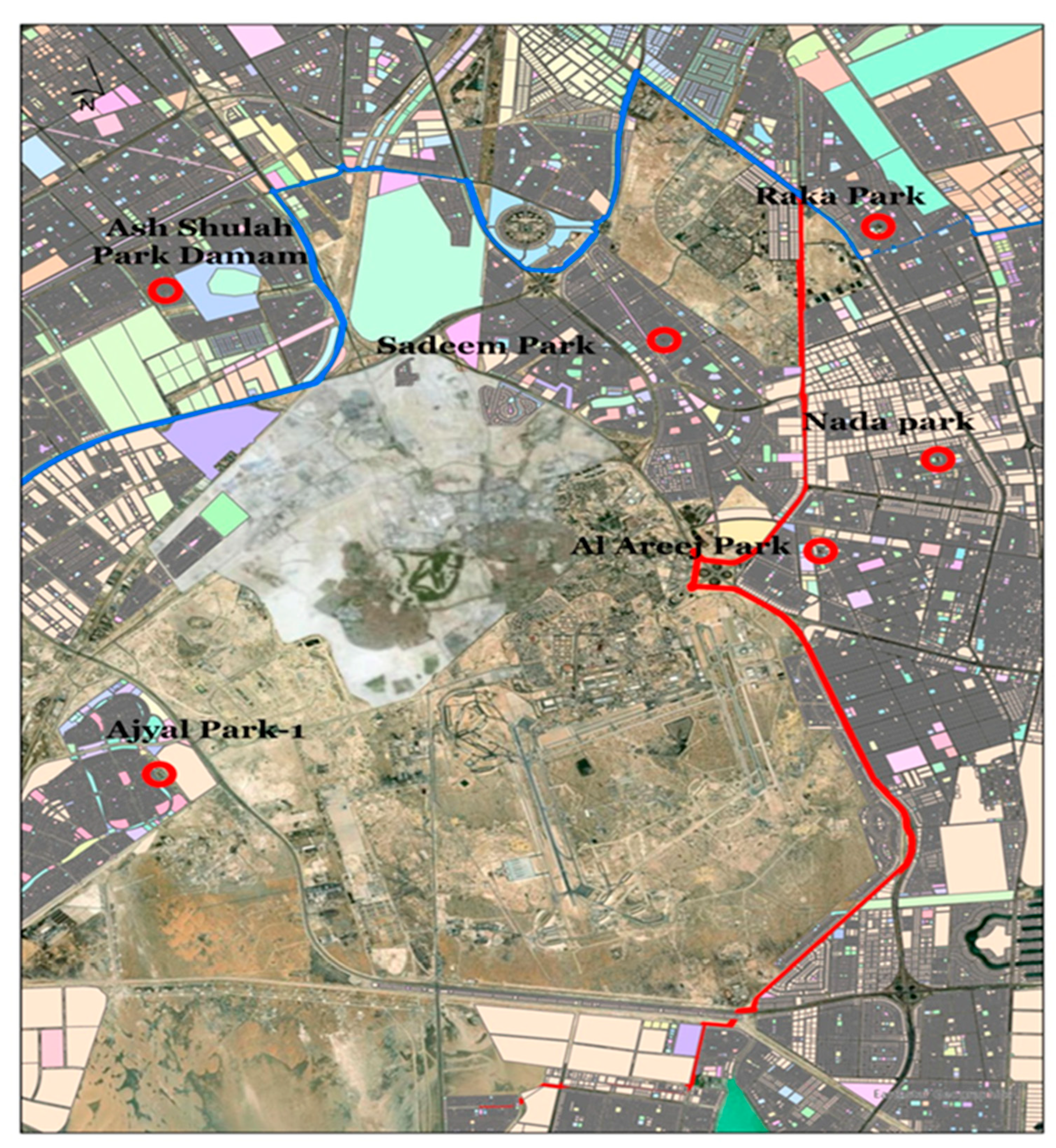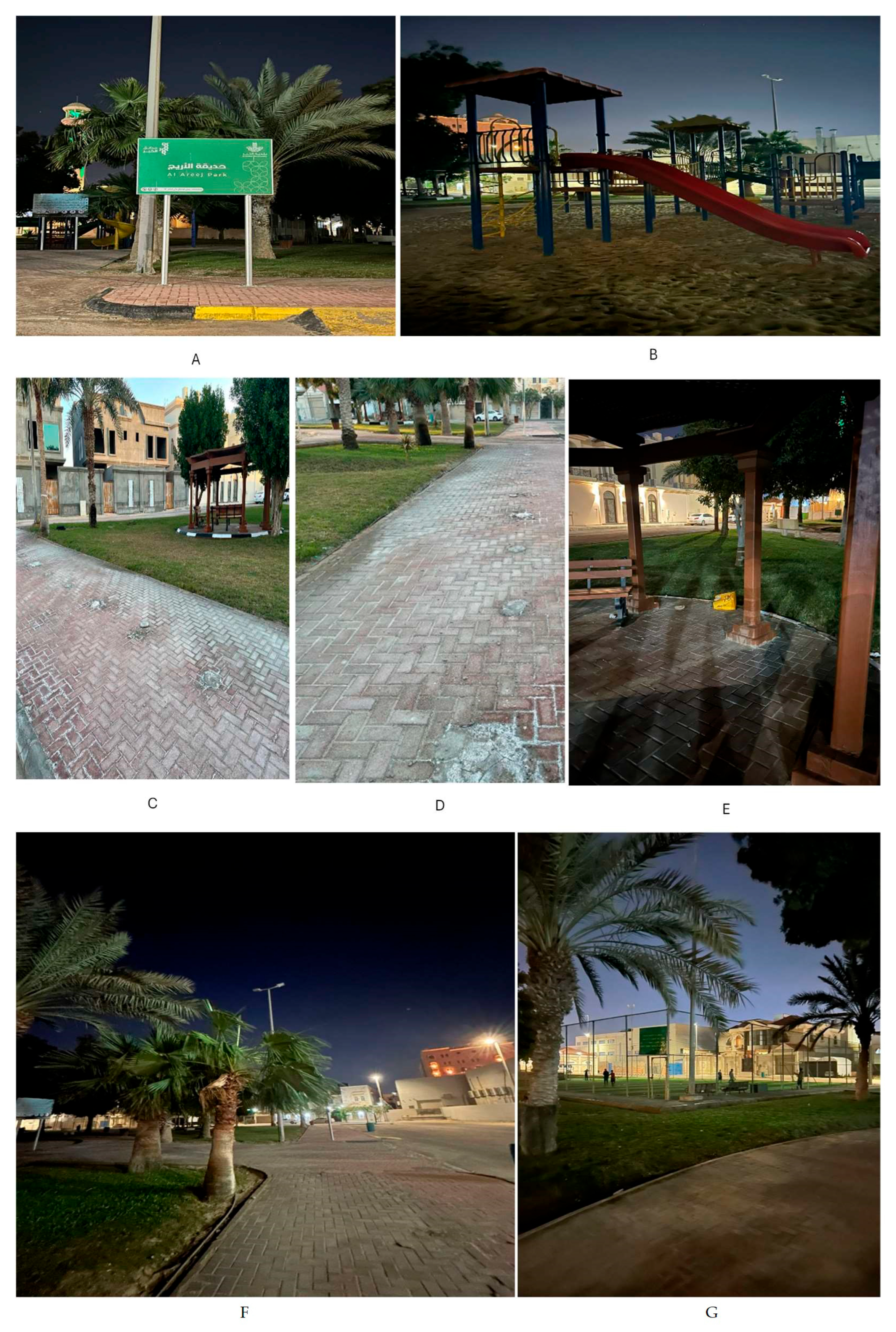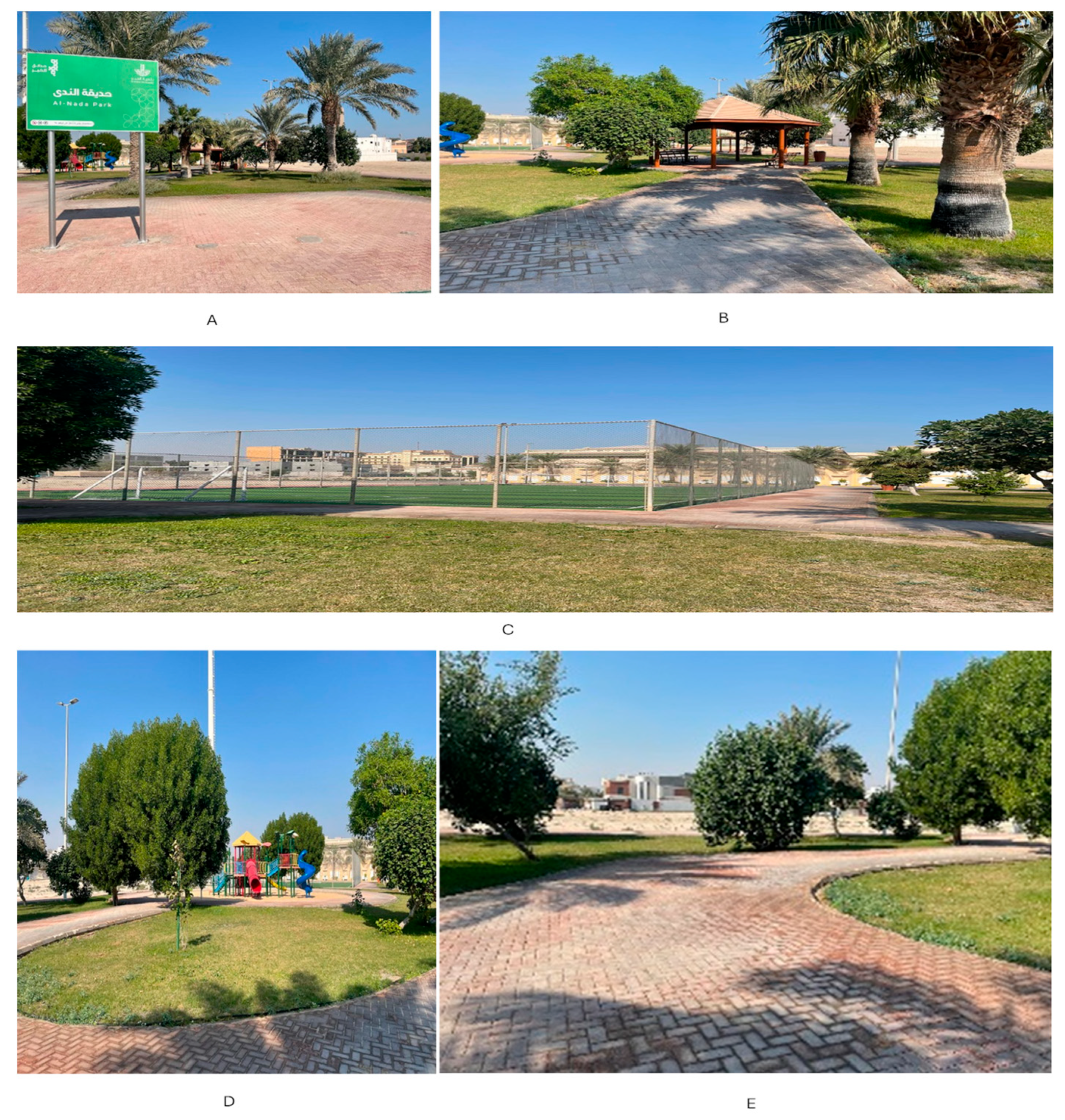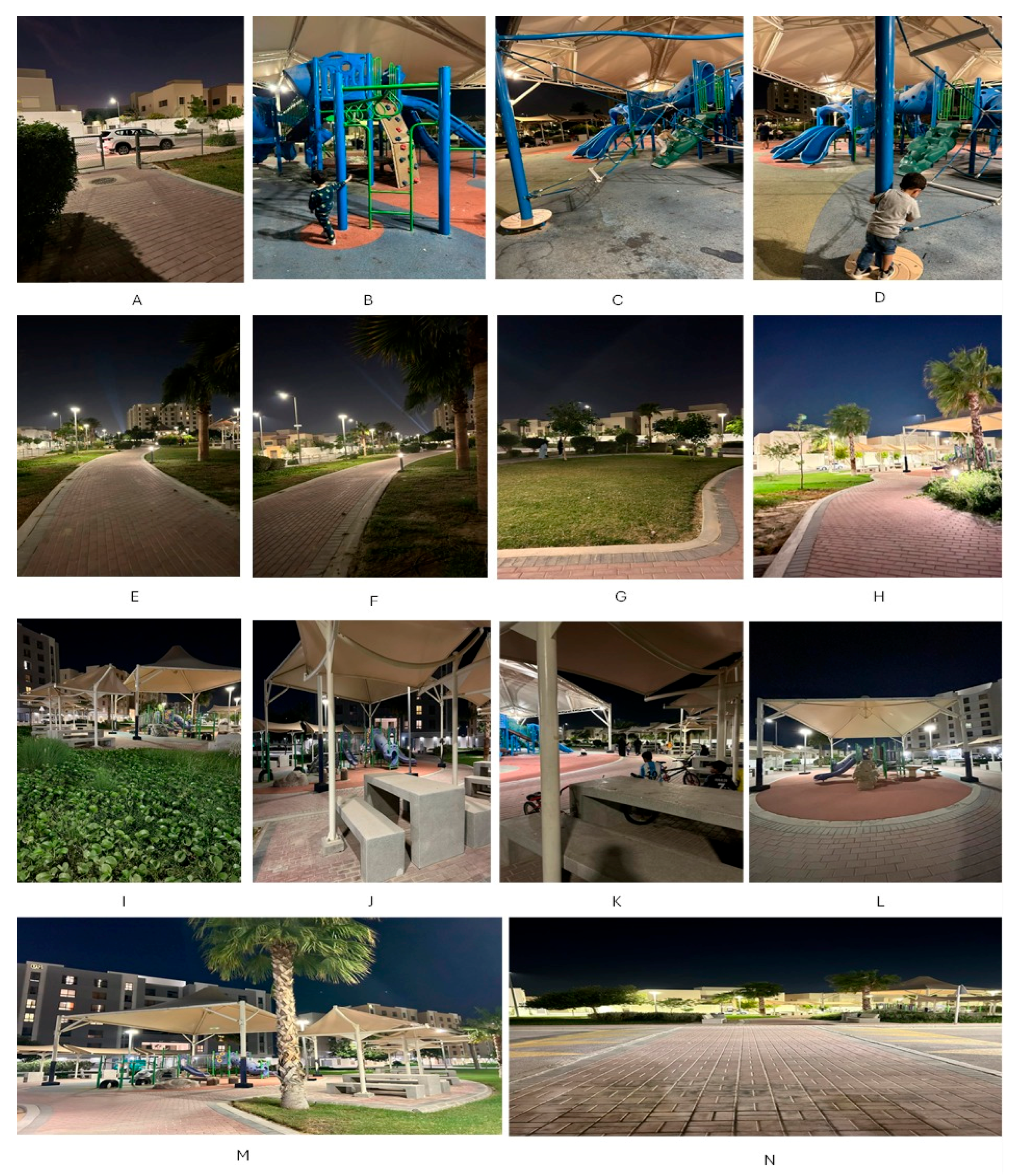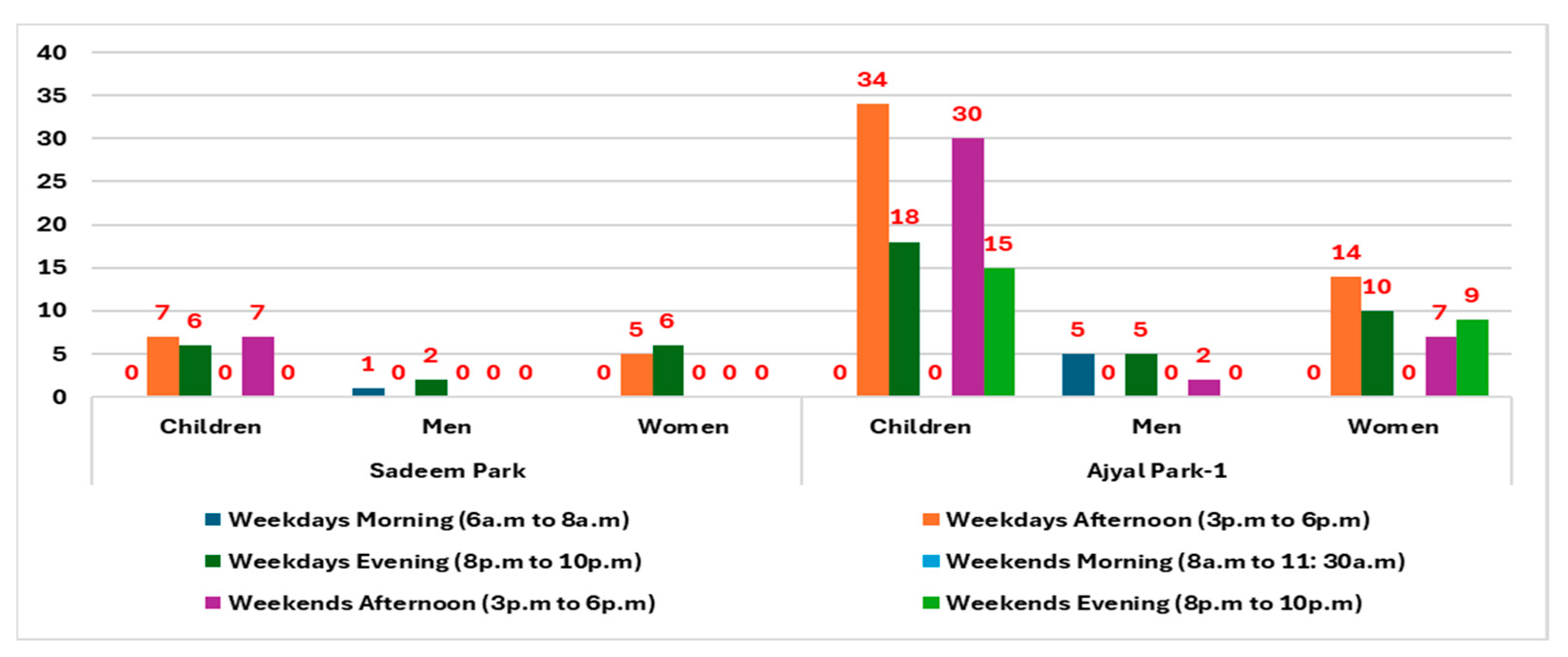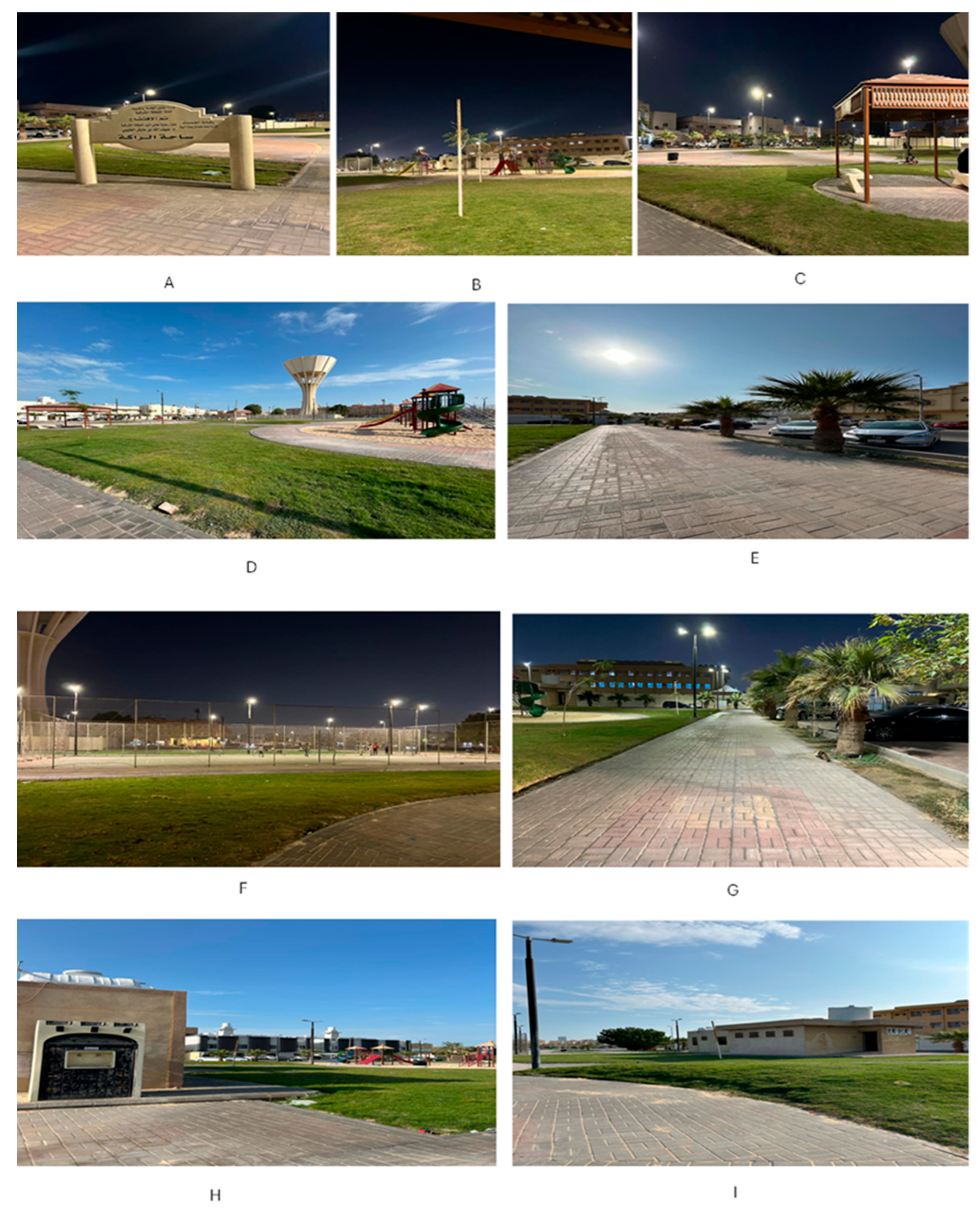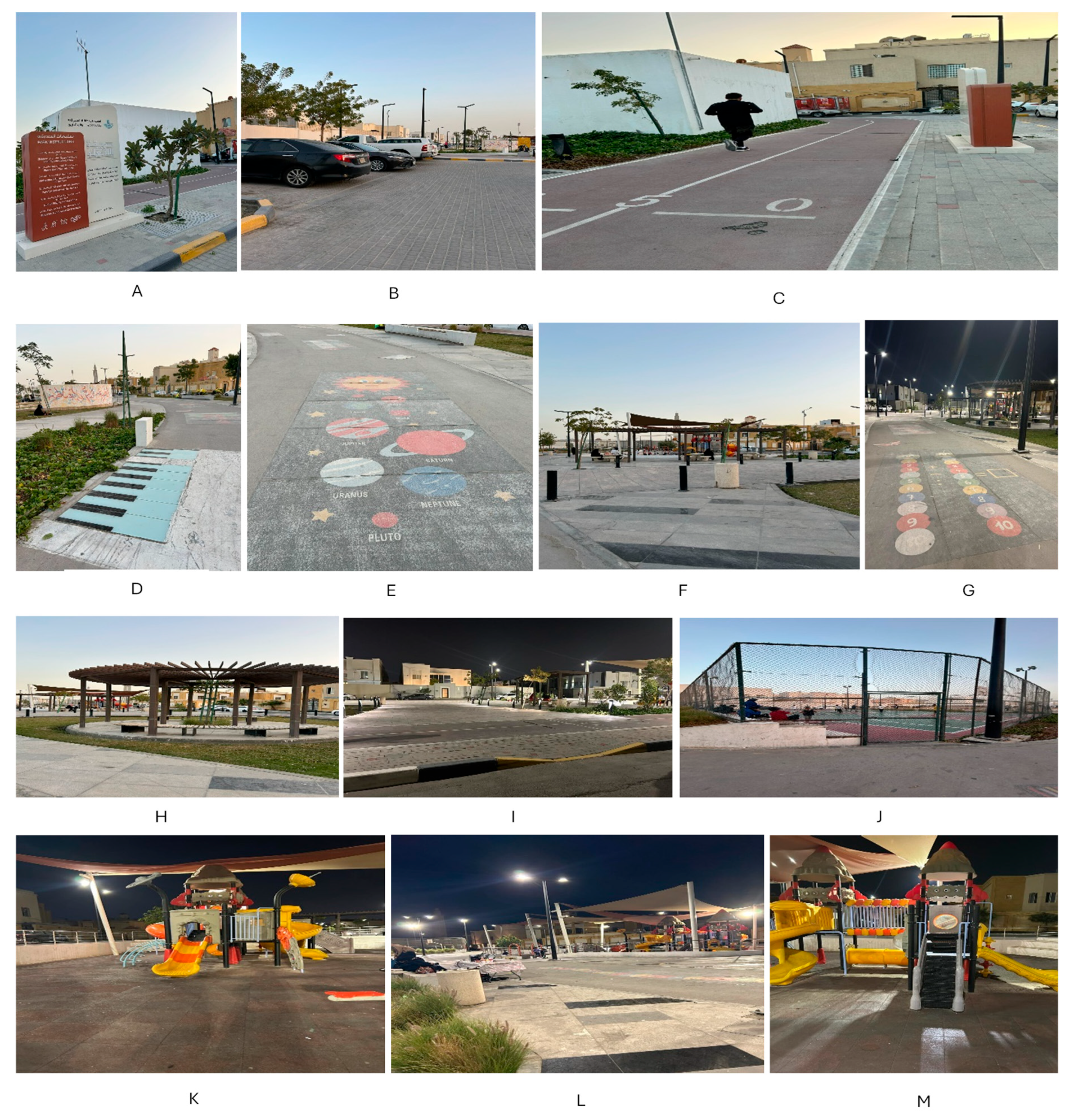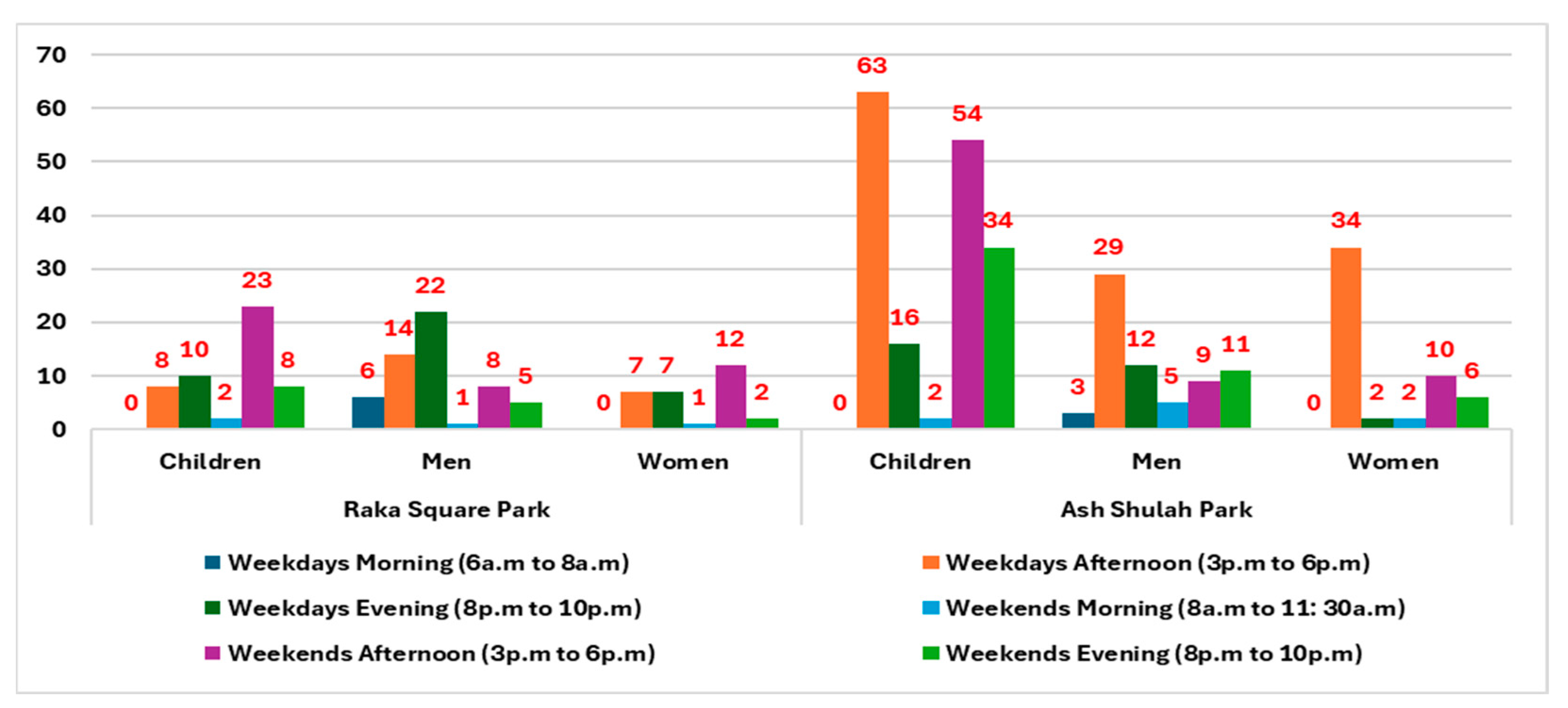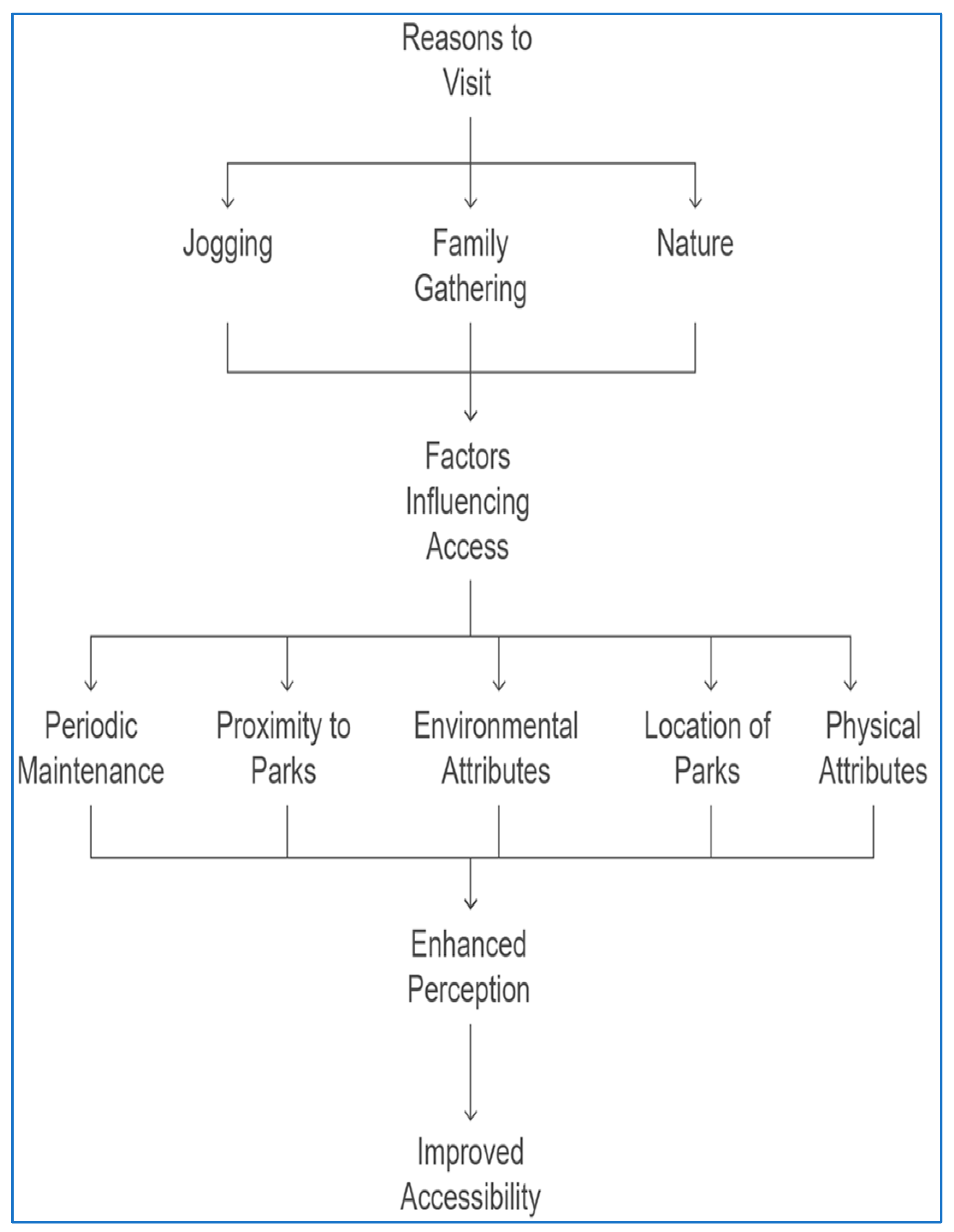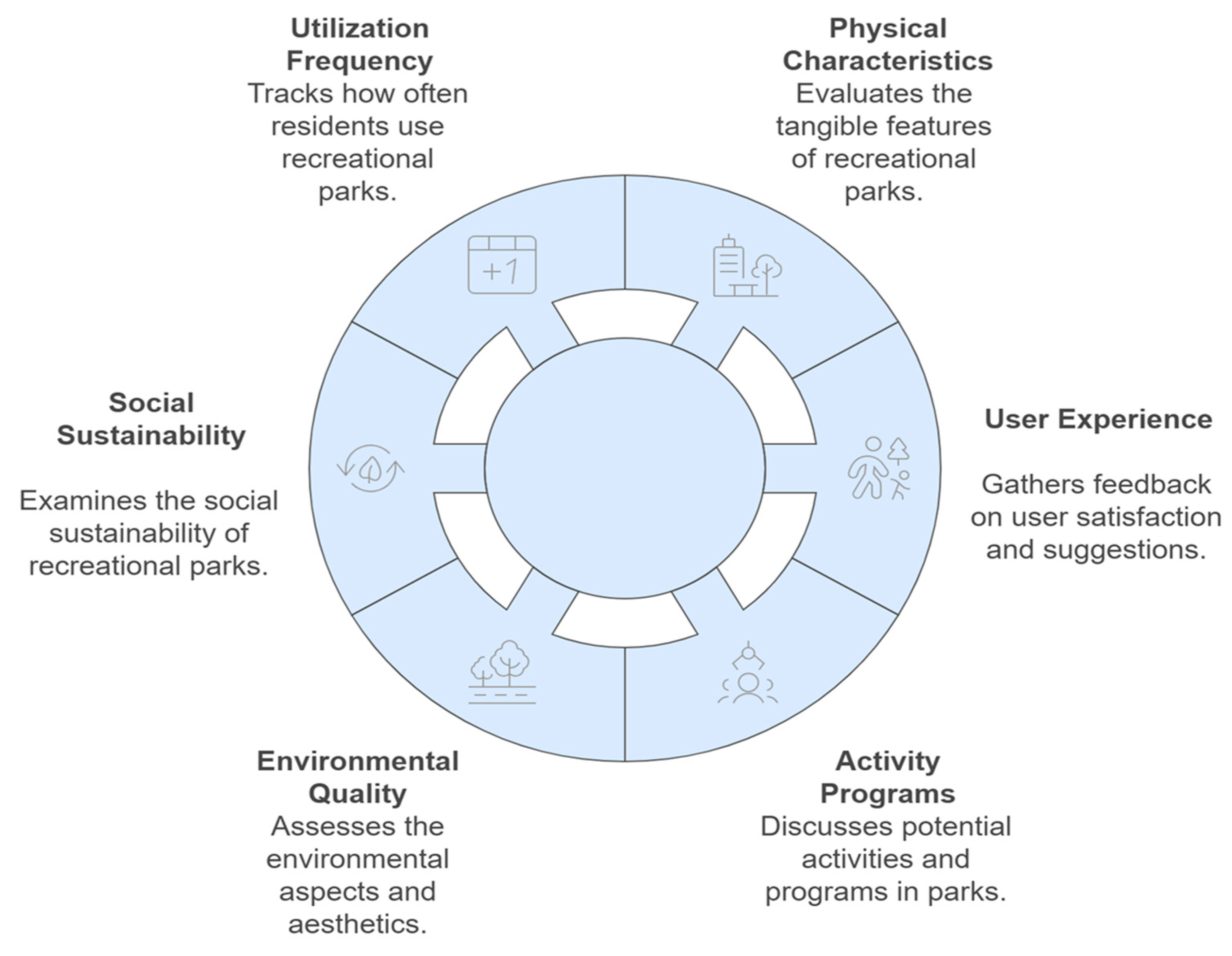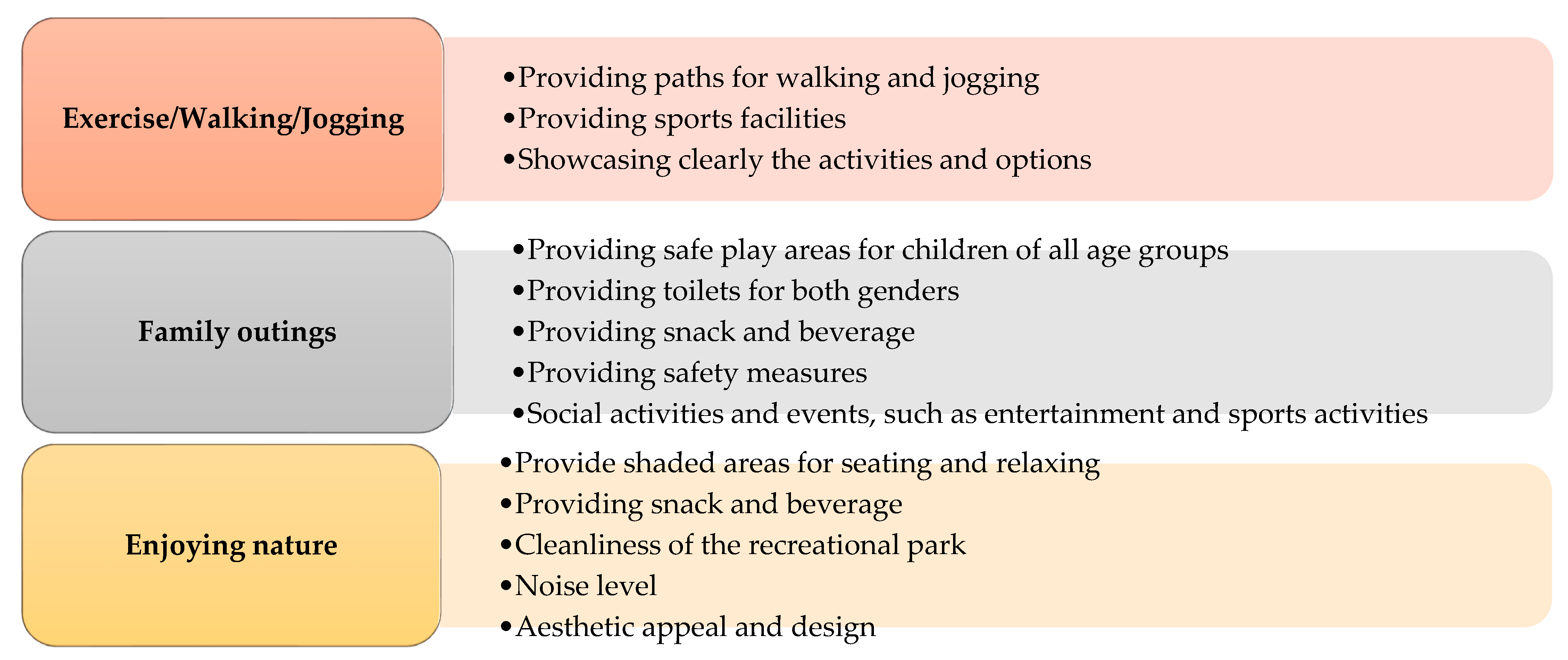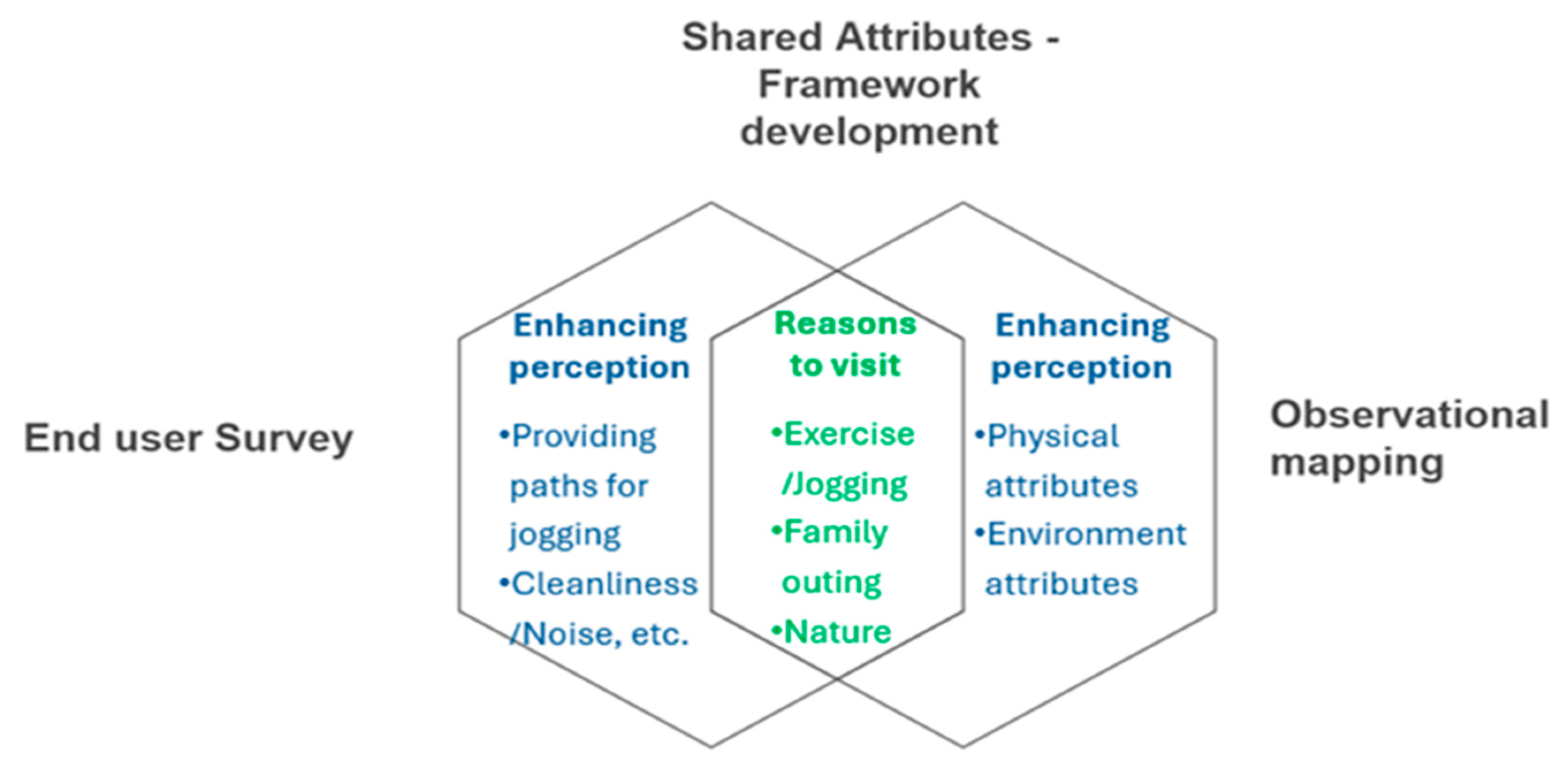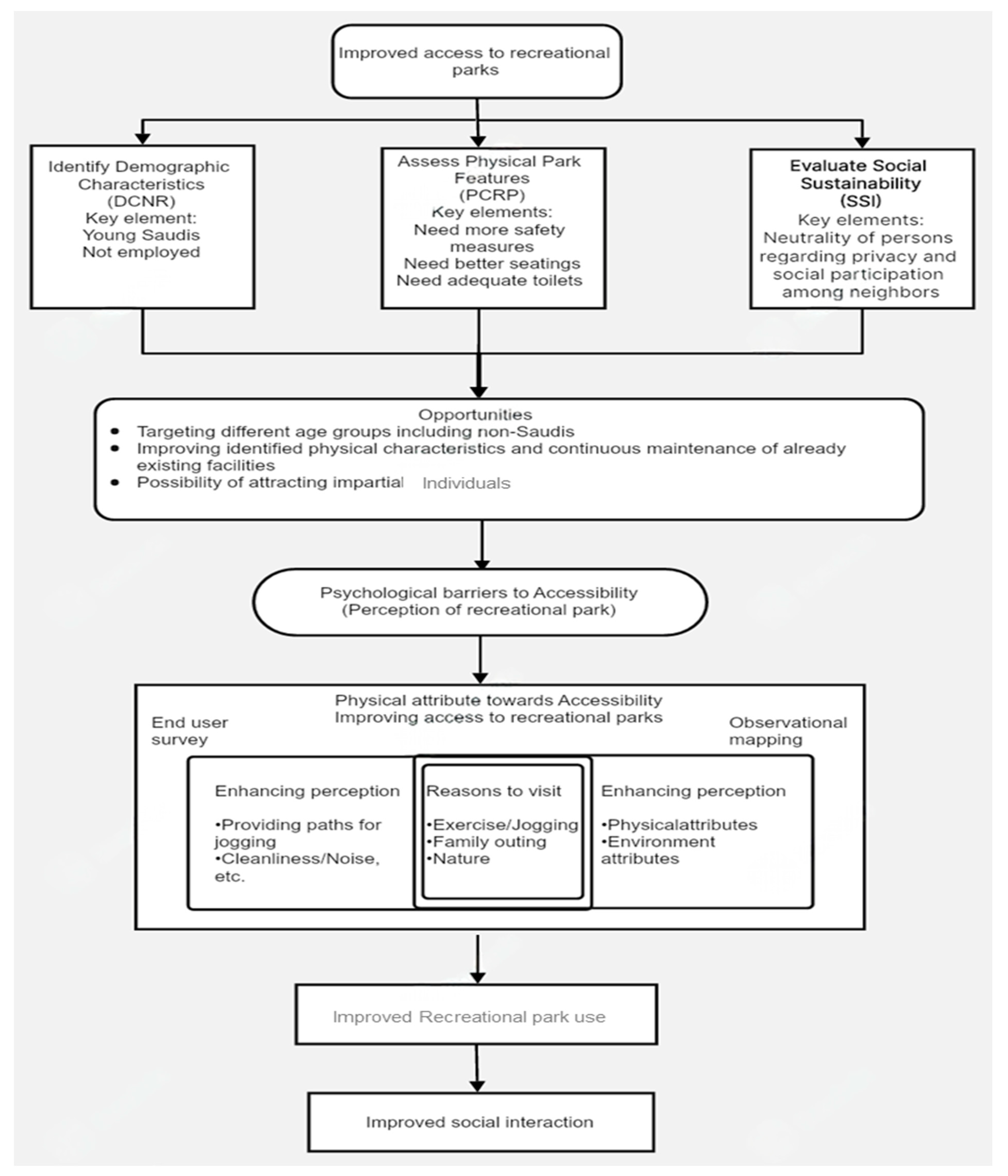This section comprises two main parts. The first analyzes end-user behavior in recreational parks across selected case studies in each DMA city to identify factors influencing accessibility. The second presents findings from the end-user questionnaire survey, which explores users’ satisfaction, perceptions, and experiences with parks in residential areas. Descriptive, cross-tabulation, and statistical analyses were conducted to examine the relationships among key variables. The following paragraphs summarize the main results from both the observational behavioral mapping and the survey.
4.1. Observational Behavioural Mapping Results
This section analyzes end users’ behavior in the recreational parks of two selected case studies in Dammam, Khobar, and Dhahran to identify and recognize the motivations and barriers that may influence the accessibility to recreational parks. The observations occurred in November 2024 and February 2025; a period characterized by mild weather in the DMA. The observations occurred twice: once on a workday and once on a weekend, conducted three different times, namely in the morning from 6:00 to 8:00 AM on weekdays and from 8:00 to 11:30 AM at weekends, in the afternoon from 3:00 to 6:00 PM, and in the evening from 7:00 to 10:00 PM. Two recreational parks were selected in each city—Khobar, Dhahran, and Dammam. The selected recreational parks in Khobar are Al Areej Park and Nada Park. The selected recreational parks in Dhahran are Sadeem Park and Ajyal Park-1. Lastly, the selected recreational parks in Dammam are Raka Square Park and Ash Shulah Park. The number of individuals using each park was recorded throughout a 15 to 20-min observation period on both weekdays and weekends, andthe data weredocumented in prepared tables (
Figure 4).
Throughout the observation periods, the temperatures were comfortable, with a low of 18 °C and a high of up to 35 °C. The weather was cold and warm on some days, except for a limited number of days characterized by hot and dry weather. The case studies are analyzed and presented. Initially, the ‘people counts’ of individuals who used the observed recreational parks are reported; thereafter, the behaviors and actions of users are documented, including their classification as male, female, or children (lessthan 18 years old).
Figure 5 represents the location of each selected recreational park in the DMA.
Case Study 1:Khobar City
Areej Park, located in the Al Ulaya neighborhood of Khobar City, covers approximately 3576 m
2 and is surrounded by single-family homes and apartment buildings. As shown in
Figure 6, the park features shaded seating areas for relaxation and social gatherings, a football field that attracts local youth, and a walking/running path bordered by green spaces. It also includes parking facilities, enhancing physical accessibility. While a children’s play area is available, it is limited in size and does not cater to diverse age groups.
Observational mapping revealed that Areej Park suffers from poor periodic maintenance, particularly of the jogging track and lighting. The uneven jogging path has caused falls, while the park remains completely unlit at night, undermining visitors’ sense of safety and negatively impacting psychological accessibility. Additionally, the park shows signs of poor cleanliness (see
Figure 6), raising health concerns and further discouraging visits. No visitors were observed during weekdays or weekends, except for seven children playing football underscoring the park’s limited use. These findings highlight the urgent need for regular maintenance, including improvements to lighting, the football field, seating, play areas, and jogging paths. Overall, the assessment emphasizes that maintenance directly affects psychological access and visitor frequency.
Nada Park, located in the Al Hizam Al Thahabi neighborhood of Khobar, is approximately 4085 m
2 and is surrounded by single-family housing. As shown in
Figure 7, the park features high visual permeability, allowing clear sightlines and visibility of recreational activities, which enhances user comfort and safety. It offers parking facilities, a walking/jogging path, and green areas, all of which contribute to its physical accessibility and visual appeal for local residents.
Although Nada Park offers several advantages, including a football field, shaded seating areas, a jogging route, and a play area, observational behavioral mapping revealed a low number of visitors on both weekdays and weekends, as shown in
Figure 8. On weekdays, 11 children were observed playing football on the field. Similarly, observational mapping indicated a very limited number of visitors on weekends. Specifically,
Figure 8 shows that 10 children were present in the afternoon and 15 men in the evening. According to the observations, playing football was the most frequent activity, primarily among children and occasionally among men.
The comparison of the two case studies in Khobar City highlights the critical role of park location (spatial distribution) within residential neighborhoods in influencing visitor numbers. Despite Nada Park’s ample physical amenities such as walking/jogging paths, play areas, rest zones, and green spaces—it experiences low visitation. This is likely because residents of villas typically have private yards or indoor playrooms, reducing their need to visit public parks. In contrast, apartment dwellers, who lack such private spaces, are more dependent on nearby parks, which explains higher visitor numbers in those areas. Additionally, the comparison underscores the importance of regular park maintenance. Nada Park suffers from uneven jogging tracks and poor lighting, especially at night, which creates safety concerns and deters visitors. Proper lighting is crucial for ensuring safety and enhancing residents’ psychological accessibility to the park. In summary, observational mapping and qualitative analysis identify two key factors limiting access to recreational parks: (1) their location relative to residential types and (2) the quality of periodic maintenance.
Case Study 2: Dharan City
Sadeem Park is situated in the Qusour area of Dhahran. The park’s estimated size is 3658.29 m
2. The park is situated in a mostly residential area characterized by single-family housing. Visual inspection of the park has shown that it offers several essential physical attributes (
Figure 9). The park offers a walking and jogging track surrounded by green spaces, and shaded seating areas for relaxation, picnics, and social gatherings. The park also provides parking spaces for easy access. In addition, the park provides a play area, which consists of several pieces of recreational equipment, and accommodatesvarious age groups in order to attract children along with their families.
Sadeem Park, like Nada Park, is surrounded mainly by residential villas and offers key physical features such as play areas, shaded sitting spots, jogging tracks, and green spaces. Despite these amenities, both parks experience low visitor numbers. Observational mapping shows little difference between weekday and weekend attendance. For example, only one man visited on the weekday morning, primarily for jogging. In the afternoon, seven children and five women visited, while in the evening, eightchildren, two men, and six women were present. On weekends, only sevenchildren were observed. Interestingly, weekday visitor numbers exceeded weekend figures, which contrasts with typical Saudi social patterns. This is likely due to the hot, sunny weather during the weekend observations. Visitors mostly come in the afternoon and evening for activities such as relaxation, running, walking, family gatherings, and supervising children, who engage in playground activities like swinging and biking. The qualitative analysis suggests that the climatic environment is a major factor influencing access to recreational parks in the DMA residential neighborhoods.
Ajyal Park-1 (
Figure 10), located in the Ajyal residential neighborhood of Dhahran, covers approximately 7944 m
2 and is surrounded by single-family homes and apartment buildings. Its location directly in front of apartments enhances physical and psychological accessibility, encouraging frequent use due to proximity. The park features a walking and jogging track, green spaces, shaded seating areas for relaxation, picnics, and social gatherings, as well as parking for easy access. It also offers recreational equipment for various age groups and a safety fence for children. However, the fence maintains visual permeability, allowing residents to see the park’s activities, which may further encourage usage.
Figure 10 illustrates visitor activities and key park amenities.
Observational mapping showed little difference in visitor numbers between weekdays and weekends, with limited use during early morning hours. As shown in
Figure 11, only five men visited on weekday mornings, primarily for jogging. In the afternoon, 34 children and 14 women were observed, while evenings saw 33 visitors (18 children, 5 men, and 10 women). Weekend visitation patterns were similar, with 30 children, 2 men, and 7 women in the afternoon, and 15 children and 9 women in the evening. No visitors were observed on weekend mornings, likely because people rest or sleep during that time. Morning visits mainly involved walking or jogging before work, while afternoons and evenings were used for leisure, jogging, family gatherings, and supervising children. Children enjoyed playing with the playground equipment, such as the slides, swings, and bicycles. Shaded seating areas allow families to watch their children comfortably. Many visitors lived in the apartments opposite the park, suggesting that proximity to residential buildings improves access and encourages the use of recreational facilities in the neighborhood.
In summary, the comparison of the two Dhahran case studies highlights that the playground area directly influences the number of child visitors and, consequently, family visits. Observational mapping also underscored the importance of key physical features such as shaded seating, jogging paths, parking, and separate toilets for men and women in encouraging longer visits. Additionally, the comparison between Ajyal Park-1 and Sadeem Park revealed that spatial distribution plays a significant role in limiting access to recreational parks.
Case Study 3: Dammam City
Raka Square Park, located in Dammam’s North Rakah Neighborhood, spans approximately 8151 m
2 and is surrounded by single-family homes and apartment buildings. Observational mapping reveals that while the park offers a large green space, its playground is inadequate and lacks equipment for various age groups, such as swings, slides, jungle gyms, and other recreational structures. In contrast, the park features a large football field, attracting children and youth for group play. It also includes a walking and jogging path surrounded by greenery, enhancing its visual appeal and encouraging physical activity. Shaded seating areas support relaxation, picnics, and social gatherings, and available parking improves accessibility.
Figure 12 highlights the park’s physical features and user activities.
Observational mapping revealed no significant difference in visitor numbers between weekdays and weekends at Raka Square Park On weekdays, only six men were observed in the early morning, primarily jogging. In the afternoon, the park saw 8 children, 14 men, and 7 women; by evening, 10 children, 22 men, and 7 women were present. Weekend mornings showed minimal activity, with just two children, one man, and one woman. However, the afternoon attracted 22 children, 8 men, and 12 women, while the evening saw 8 children, 5 men, and 2 women. Overall, attendance was low across all periods, suggesting underlying factors that limit community use. Men and women primarily visited in the afternoon and evening for jogging, relaxing, socializing, and supervising children. Football was a common activity among men, and children mostly used the limited playground and football field. Compared to other parks like Ajyal-1, Raka Square Park attracted fewer children, largely due to the inadequate play area, which lacks diverse equipment for different age groups. This highlights the importance of well-equipped, age-inclusive playgrounds in attracting families. Additionally, the park lacks sufficient shaded seating, forcing visitors to use mats or other items. The absence of proper seating may hinder both formal and informal social interactions.
Ash Shulah Park, located in Dammam’s Ash Shulah Neighborhood, spans approximately 1821 m
2 and is surrounded by single-family homes and apartment buildings. The park offers high visual permeability, allowing clear views of all areas and activities, which enhances its appeal and sense of safety. It includes designated parking and an accessible entrance for people with disabilities, promoting inclusivity and improving both physical and psychological accessibility. Key features include a wide walking and jogging track, expansive green spaces, and playgrounds that cater to various age groups encouraging family visits. The presence of food and drink kiosks further supports visitors’ comfort, especially in cooler weather.
Figure 13 highlights visitor activities and the park’s physical attributes.
Observational mapping revealed no significant difference in visitor numbers between weekdays and weekends. As with previous case studies, weekday morning visits were limited to men, 21 in total, mainly for jogging before work. In the afternoon, 63 children, 29 men, and 34 women visited the park, while evening attendance included 16 children, 12 men, and 2 women. Similarly, weekend visitation patterns mirrored weekdays. As shown in
Figure 14, afternoon visitors included 54 children, 9 men, and 10 women, while in the evening, 34 children, 11 men, and 6 women were observed. Morning attendance remained minimal, as most people tend to rest on weekends.
Morning visits are primarily for walking or jogging, highlighting the importance of jogging tracks as a key draw for this group. In the afternoon and evening, visitors, both men and women use the park for relaxation, exercise, socializing, and supervising children. Children frequently use the playground, ride bicycles, and play football. These patterns underscore the importance of various physical features in attracting diverse users: inclusive play areas, shaded seating, green spaces, football fields, and jogging tracks. Ultimately, the quality and accessibility of these features influence residents’ psychological perception of the park, which in turn affects its regular use.
Analysis of visitation data for the two recreational parks in Dammam highlights the significant impact of playground facilities on attracting children and, consequently, families. Observational mapping shows that Ash Shulah Park includes diverse play equipment suitable for various age groups, while Raka Square Park offers only limited play space, resulting in fewer child visitors. In the Saudi context, children typically visit parks with their families, making playgrounds a key factor in overall attendance. Alongside play areas, other essential features that encourage visitation include restrooms, shaded seating, jogging tracks, football fields, green spaces, and food and beverage kiosks. Notably, park size alone does not determine usage. For instance, although Raka Square Park spans 8151 m2 and Ash Shulah Park only 1821 m2, the latter receives significantly more visitors. This underscores the importance of amenities over sheer area.
Table 2 presents visitor numbers across the three case studies—Khobar, Dhahran, and Dammam—using a color gradient to indicate the highest and lowest visitation levels during weekdays and weekends across morning, afternoon, and evening time slots.
In summary, this study focuses on the factors influencing access to recreational parks and their impact on park usage and community engagement among neighborhood residents. While traditional studies emphasize physical accessibility, extensive literature highlights its limitations in predicting park use. Therefore, physical access must be complemented by perceived or psychological accessibility. Enhancing safety, cleanliness, attractiveness, maintenance, andaccessibility, and offering diverse activities for all age groups can help reduce psychological barriers and increase visitation. Based on the comparison of the three case studies—Khobar, Dhahran, and Dammam—
Figure 15 illustrates the key factors affecting access to recreational parks in residential neighborhoods.
Observational behavioral mapping has revealed that the neighborhood residents are visiting the recreational parks for three main reasons:jogging, family gatherings, and enjoying nature. This result is exactly consistent with the output of the end-user questionnaire survey conducted in the present study. Based on the qualitative analysis of observational behavioral mapping, five key factors have been revealed that may influence access to recreational parks:periodic maintenance, proximity, environmental and physical attributes, and lastly, the location of the parks. Consequently, enhancing the individual’s perceptions regarding these factors may reduce psychological barriers, improve access to the parks, and subsequently increase frequent use and social interaction. Similarly, the photographic documentation of the selected parks indicates that, in general, there are no major physical obstacles that would hinder access for individuals with physical disabilities. Most paths appear wide and level, and entrances are unobstructed. However, the images do not show specialized accessibility features such as tactile paving, auditory navigation aids, or adapted furniture for individuals with visual or other sensory impairments. The absence of such features suggests a gap in universal design practices, which should be considered in future park upgrades to ensure inclusivity for all users.
Table 3 and
Table 4 below present a summary of key features across selected recreational parks and a summary of the conditions of the selected recreational parks, respectively.
4.2. End-User Questionnaire Survey Results
An online questionnaire was administered to residents of the DMA between December 2024 and February 2025. The survey was launched on 15 December 2024 and successfully completed by 256 participants, with no dropouts reported. On average, it took less than three minutes to complete. The questionnaire was hosted on the QuestionPro platform, which enabled secure and user-friendly submission of responses. Participants were given the option to complete the survey in either Arabic or English. Prior to beginning the questionnaire, all respondents were clearly informed about the purpose and objectives of the study to ensure informed participation.
The end-user questionnaire survey was designed to gain insight into residents’ perceptions, experiences, and preferences regarding recreational parks in residential neighborhoods within the DMA. The questionnaire consisted of several sections. The first twelve questions gathered demographic data, including locality, nationality, gender, age group, housing type, marital status, education level, employment status, workplace location, income, and family proximity. For instance, over 50% of respondents lived in Khobar, while nearly 24% were from Dammam. About 72% were Saudi citizens, 67% were male, and 46% were aged 18–24. Additionally, 46% lived in employer-provided housing, 74.6% were single, 35% had not completed their education, and 73% were unemployed. Among those employed, 55% worked within their neighborhoods, 57% earned less than 5000 SAR monthly, and around 52% reported having relatives nearby.
Table 5 presents the demographic details of the participants.
Beyond demographic information, the survey included questions focused on the purpose and frequency of park visits, the types of activities engaged in, and the evaluation of tangible park features. Respondents were asked to rate elements such as periodic maintenance, proximity, lighting, and the availability of facilities (e.g., toilets for both genders, play areas, and seating). Environmental and aesthetic aspects, such as cleanliness, air quality, and landscaping, were also assessed. In addition, the survey explored users’ psychological impressions, including feelings of safety, privacy, and overall comfort within the parks.
Participants were also asked to express their preferences regarding potential programs and activities, such as events or recreational offerings that could foster social inclusion and interaction. In the context of this study, social inclusion refers to the ability of recreational parks to foster equitable access and meaningful participation for all community members, regardless of age, gender, socioeconomic background, or physical ability. It involves creating spaces where individuals feel welcomed, safe, and able to interact without discrimination or exclusion. Socially inclusive parks promote shared experiences, community bonding, and engagement among diverse user groups, contributing to broader goals of urban resilience and social sustainability. This aligns with the objectives of sustainability by emphasizing the role of public spaces in promoting inclusive urban environments. Therefore, by capturing these multifaceted perspectives, the survey provides a comprehensive understanding of both the functional and experiential qualities of parks, as perceived by residents. A sample of the questionnaire is included in
Supplementary Materials, and a summary of the survey structure is presented in
Figure 16.
The physical factors were measured using a Likert scale, and a one-way ANOVA test yielded a
p-value less than 0.05, indicating a statistically significant difference among the physical factors, as shown in
Table 6 below.
It was important to summarize the highest and lowest-ranked physical factors that might affect how often people use recreational parks. Consequently,
Figure 17 shows the complete analysis of the satisfaction of the participants regarding the physical attributes of the recreational parks in the DMA. The analysis revealed that respondents expressed high satisfaction with amenities like sufficient lighting, pedestrian routes, secure play areas for children, and the proximity of the recreational parks, as illustrated by the red borders in
Figure 17. More than 30% of respondents expressed high satisfaction. On the other hand, the analysis revealed that no facilities other than “design of seats for enhancing social inclusion” showed an overall rating of less than 3. Subsequent investigation revealed that respondents exhibited relatively low satisfaction with the facilities, such as toilets for both genders, availability of snacks, and various safety measures within recreational parks.
Accordingly, based on
Figure 17,
Table 7 highlights the key physical factors that need to be maintained and those that require improvement to encourage more frequent park visits. Additionally, this table supports the identification of essential elements for the development of the proposed framework.
Social sustainability characteristics were also measured on a Likert scale, with a significant result. Many participants (about 32%) had neutral opinions about their overall experience with neighborhood parks, suggesting they may be more open to persuasion. Moreover, the analysis showed that most people visit parks for exercise, family outings, and relaxation in nature. It recommends focusing on amenities that support these activities. To boost park visits, it isimportant to improve certain key aspects. Therefore, this study also identified key physical factors that need to be maintained or improved to encourage and improve park visits.Many respondents were dissatisfied with toilet facilities for different genders and the availability of snacks, as well as safety measures, suggesting that enhancements in these areas could attract more visitors. Additionally, over 68% of people were unhappy with the environmental design, indicating that improvements in noise levels, climatic response design, aesthetics, and cleanliness could enhance overall user experience. In addition, the analysis showed that more people were satisfied (44%) with the recreational parks than those who were dissatisfied (24%). Thus, it shows that, overall, people are happy with the current conditions of the recreational parks. However, they still prefer other places (53%) to meet with friends than recreational parks (47%). Although the difference is currently small, various factors could be contributing to it. For example, a significant percentage of respondents (68%) expressed dissatisfaction with the climate and environmental conditions of the parks. Similarly, the overall perception of the parks can also be assessed by the fact that the majority of people (50%) either never use the parks (20%) or visit just once or twice a year (30%). Overall, according to the analysis, a significant number of respondents (32%) did not have a positive or negative opinion of the overall experience of recreational parks in their neighborhood. A psychological perspective can be utilized to explain the fact that individuals with a neutral stance, as opposed to dissatisfied individuals, tend to be more receptive to persuasion in general. This is because neutral individuals are less likely to have preconceived biases or strong emotional reactions that can hinder openness to new information. As a result, they are more likely to consider different viewpoints and be influenced by persuasive arguments.
Figure 18 illustrates the primary characteristics discovered that may influence access to recreational parks and, therefore, the regular use and social interaction in the DMA.
The end user questionnaire survey reveals that recreational parks in the DMA are visited for three main reasons: exercising, walking, and jogging;family outings;and nature relaxation. Consequently, more focus should be placed on facilities related to these factors where individuals’ perceptions are significantly influencing their accessibility to recreational parks. Based on the analysis of end-user satisfaction, perceptions, and preferences regarding recreational parks, the study suggestsseveralkey recommendations.These include providing paths for walking and jogging, safe play areas for children, toilets for both genders, snack and beverage options, shaded areas for seating and relaxation, and giving more attention to cleanliness and the aesthetic appeal of the recreational parks. In addition, providing some social activities and events, such as entertainment and sports activities, is recommended. Lastly, it is important to clearly showcase the available activities and options to neighborhood residents.
